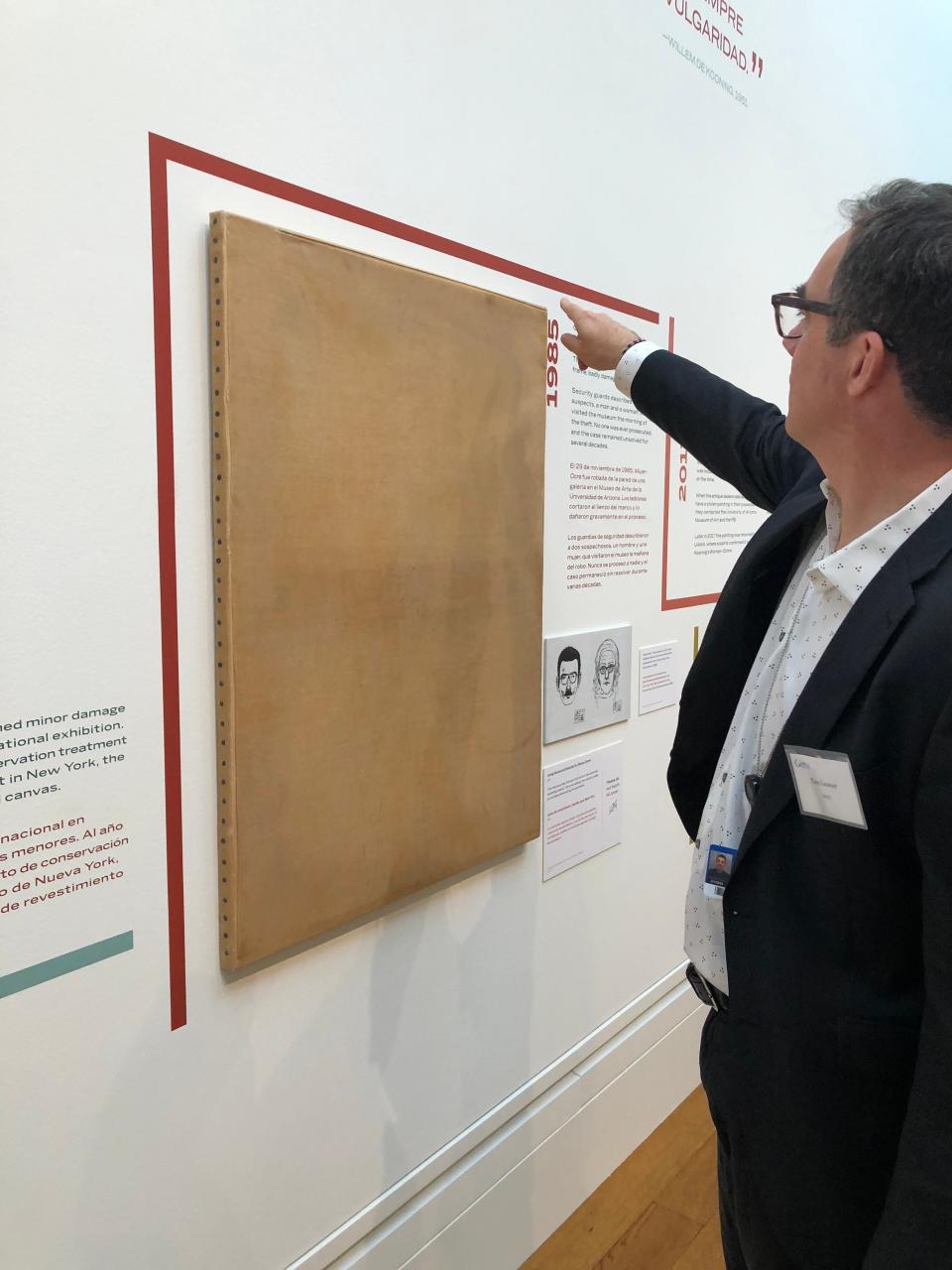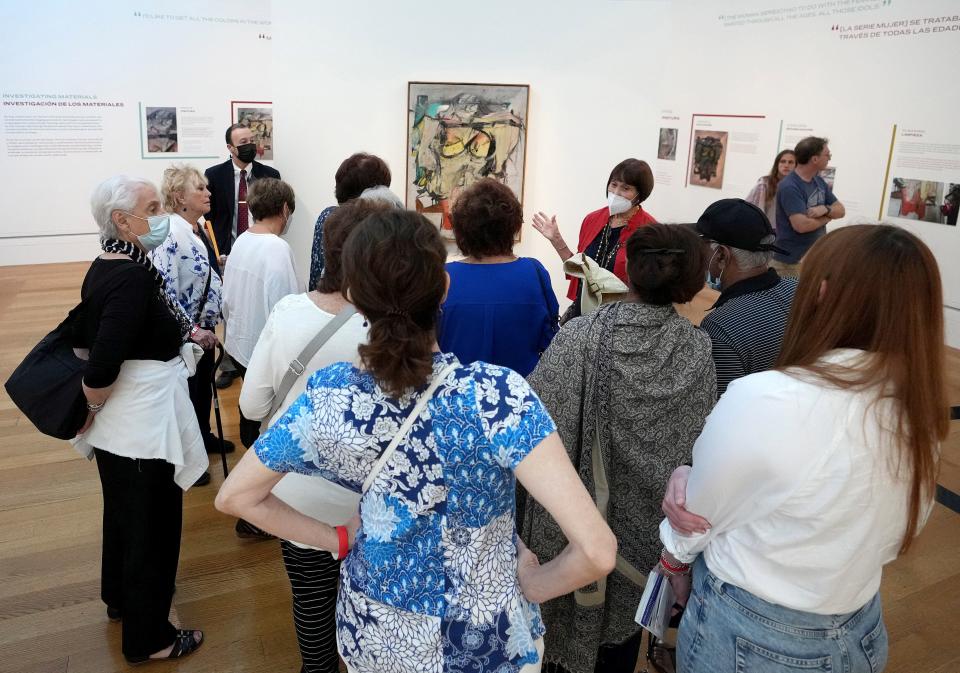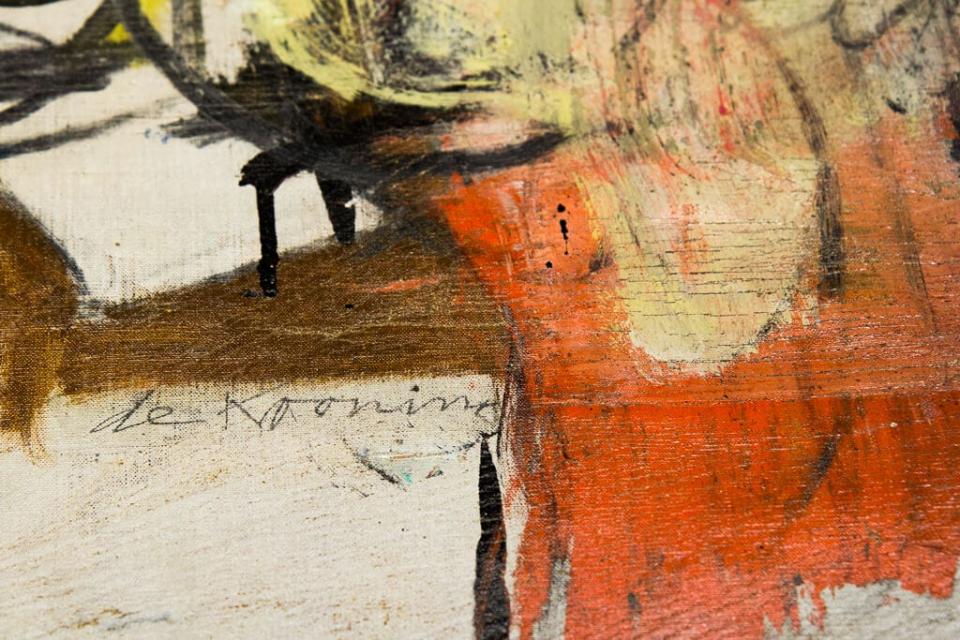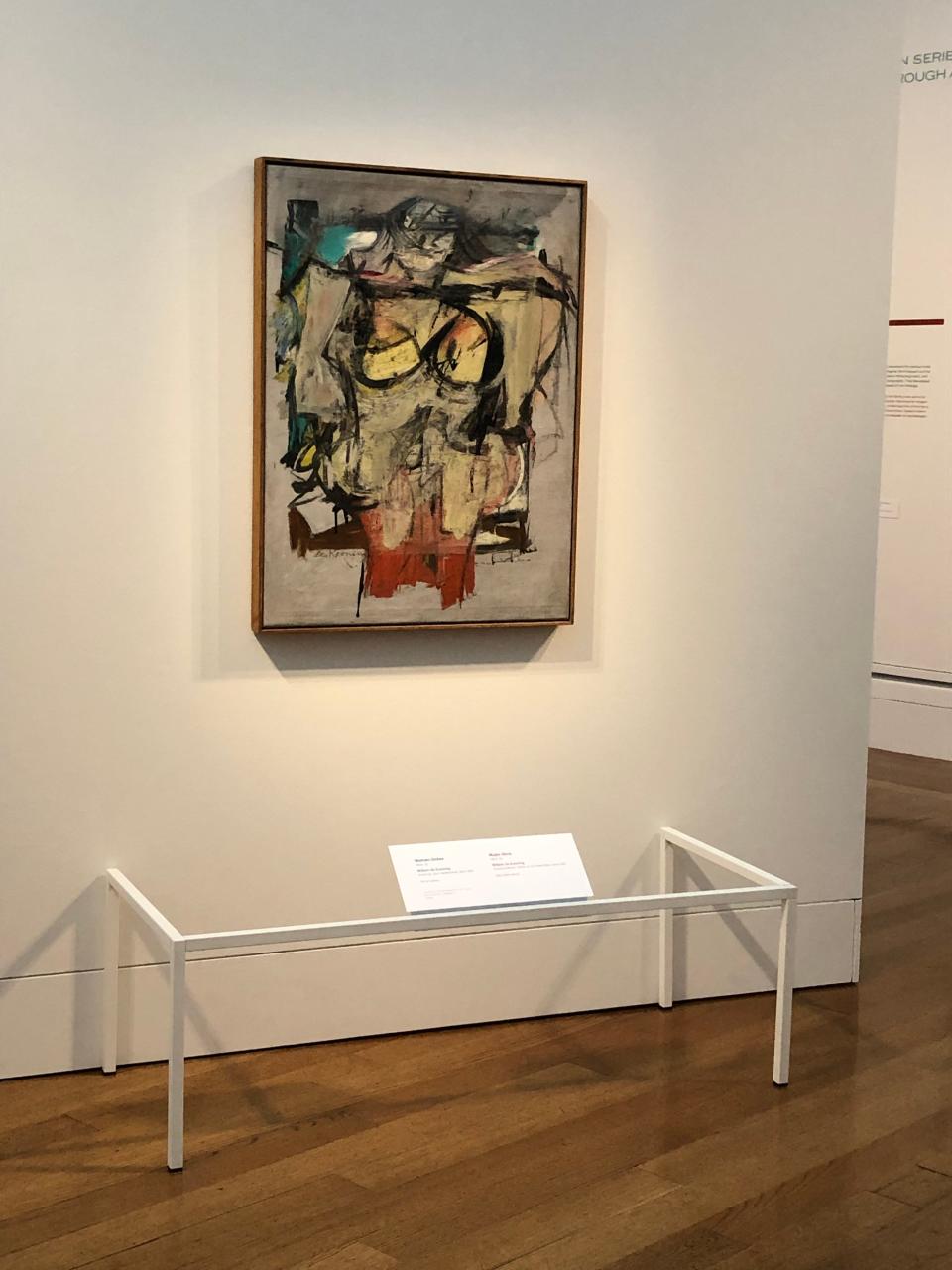From dusty bedroom to the Getty Museum: Long-lost de Kooning painting is back on exhibit
Shortly after 9 a.m. on Tuesday, a worker at the J. Paul Getty Museum put the finishing touches in the gallery that showcases "Woman-Ochre."
He peeled a paper strip from the wall, revealing a quote by the painting's Dutch-American artist, Willem de Kooning:
"I don't paint for a living. I live to paint," it said.
And with that, de Kooning's now famous stolen and recovered painting was back on exhibit after being mostly hidden for the last 37 years.
A guard was never more than a few feet away.
Visitors filed past, clutching museum maps in their hands. Some swept through quickly. Others lingered, pointing to de Kooning's distinctive brush strokes and the vivid hues of yellow, turquoise and crimson.
Visitors learned about the painting's daring heist from the University of Arizona Museum of Art in 1985 and surprising recovery three decades later in a New Mexico antique store. They also got a behind-the-scenes look at how the $100 million painting was repaired so it could go back on exhibit.

Greg Halamicek made an hour-long drive with his wife, Tina, and son, Patrick, from their home in Lancaster to see "Woman-Ochre." As their vehicle inched along in morning traffic, he said he told his family about the painting's theft and recovery.
"The story is fascinating," he said.
He wonders how many other paintings have gone missing.
For subscribers: The saga of Arizona's famous stolen de Kooning painting. New details paint picture of alleged thieves
Tina Halamicek found "Woman-Ochre" remarkable and beautiful, something she could look at for hours.
Patrick Halamicek had more practical observations about how the university will protect the painting when "Women-Ochre" returns to the art museum this fall.
"I imagine they will up the security," he said.
Some reactions were more simplistic. A guide led a group past the painting — which depicts a nude woman seated, her mouth twisted into a grimace — and asked visitors, "What is the first thing you see when you look at the painting?"
"I see boobs," a woman said.
"Woman-Ochre" is part of a series that de Kooning painted in the 1950s known as the “Women” paintings. They were dramatic, aggressive depictions of women with big mouths, wide eyes and exaggerated breasts.
In the winter of 1954-55, he made an oil painting of a nude woman, her breasts accented in yellow. He added hues of turquoise, green, crimson and orange against a neutral background. De Kooning sold the work, titled “Woman-Ochre," in 1955. Three years later, a Baltimore businessman who liked to vacation in Arizona, Edward Joseph Gallagher Jr., donated the painting to the university's art museum.
After it was stolen, "Woman-Ochre" hung in a dusty gold frame in the bedroom of Jerry and Rita Alter, a retired couple who lived in a small New Mexico town. It was only after the Alters both died that the art was recognized as stolen by three antique dealers. They immediately called the museum and returned it.
The oil-on-canvas painting couldn't go back on exhibit because it was severely damaged in the theft.
It took a team of scientists, conservators and imaging specialists at the Getty Museum and the Getty Conservation Institute to tackle the complex conservation. The project stretched for nearly three years.

The thieves used a sharp object, possibly a box cutter, to slash "Woman-Ochre" from its frame. But they were likely unaware there was a secondary canvas, attached to the main canvas by a waxy resin. The blade didn't go all the way. So the thieves ripped the painting out, creating horizontal cracks.
"There was a lot of violence to the way the canvas was pulled away from the backing canvas. The word trauma comes to mind," said Tom Learner, head of science at the Getty Conservation Institute.
The thieves further damaged the painting by rolling it up — face in — and hiding it under a winter coat so it could be smuggled out.
"It was among the most damaged paintings I've ever seen. Certainly, the most damaged painting that I have ever worked on," said Laura Rivers, associate paintings conservator at the J. Paul Getty Museum.

It's a bit like reconstructive surgery. Do too much and the painting looks over-restored. The goal is just enough to let the painting do the talking.
Rivers had to reattach lifted and flaking paint using custom tools and a microscope. She found paint fragments scattered across the surface, creating a "visual noise," that disrupted the image. Those had to be removed.
The work was slow. She might cover only an inch a day. The COVID-19 pandemic further slowed progress; at one point Rivers was limited to working in the conservation lab only one day a week.
"Woman-Ochre" had two coats of varnish that gave the painting a grayish or yellowish tint. One was applied in the 1970s when the university loaned the painting to the Museum of Modern Art in New York City. The other varnish was added after the painting was stolen.

Rivers used solvent mixtures to remove the varnishes. One of the varnishes was almost sticky at room temperature.
"So it had gathered up almost every fragment of dust that had floated past in Arizona or New Mexico," she said.
She described the cleaning procedure as "an extraordinary privilege."
For subscribers: $100 million de Kooning was recovered in 2017. New details paint picture of alleged thieves
Paint was also missing in places. Ulrich Birkmaier, senior conservator of paintings at the Getty Museum, filled in the losses with pigments. He used a tiny paintbrush that barely touched the surface. Pigments were only applied where paint was missing, never painted on top of de Kooning's work.
"If you liken it to a puzzle, you only fill in the pieces that are missing," said Birkmaier, in an interview with The Arizona Republic in May.
The theft is still fresh in people's minds. But in 50 or 100 years, the theft may not be the first thing people think of when they look at "Woman-Ochre," he said.
"Hopefully, there's just a painting with some slight scars (that) to the casual viewer won’t be visible really," he said.
How to see 'Woman-Ochre'
What: Willem de Kooning's "Woman-Ochre" is an oil painting he made in the winter of 1954-55. The artwork is part of his famous Women series where the Dutch-American artist explored the female figure. The Women paintings shocked the art world because of their aggressive nature where the female form is characterized by wide eyes, big mouths and exaggerated breasts.
Painting's history: "Woman-Ochre" went on display at the Martha Jackson Gallery in New York City in 1955 before being purchased by Baltimore businessman Edward Joseph Gallagher Jr. in 1957. The next year, Gallagher donated "Woman-Ochre" and other works to the University of Arizona Museum of Art. The painting was valued at $6,000 at the time.
Estimated worth: The university is no longer putting a value on the painting, but in 2015 the estimated value was up to $160 million.
In Los Angeles: "Conserving de Kooning: Theft and Recovery" is at the Getty Center from June 7 to Aug. 28. See the Getty's website for more information.
In Tucson: On exhibit at the University of Arizona Museum of Art, beginning Oct. 8. See the museum's website for more information.
Republic reporter Anne Ryman was the first journalist to break the story that "Woman-Ochre" had been recovered and has written extensively about the painting. Have a question about the painting? You can reach her at anne.ryman@arizonarepublic.com or 602-444-8072. Follow her on Twitter @anneryman.
Reach the reporter at anne.ryman@arizonarepublic.com or 602-444-8072. Follow her on Twitter @anneryman. Support local journalism. Subscribe to azcentral.com today.
This article originally appeared on Arizona Republic: Stolen and recovered de Kooning painting makes big debut

